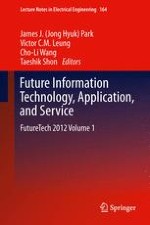This book is proceedings of the 7th FTRA International Conference on Future Information Technology (FutureTech 2012). The topics of FutureTech 2012 cover the current hot topics satisfying the world-wide ever-changing needs.
The FutureTech 2012 is intended to foster the dissemination of state-of-the-art research in all future IT areas, including their models, services, and novel applications associated with their utilization. The FutureTech 2012 will provide an opportunity for academic and industry professionals to discuss the latest issues and progress in this area. In addition, the conference will publish high quality papers which are closely related to the various theories, modeling, and practical applications in many types of future technology. The main scope of FutureTech 2012 is as follows.
Hybrid Information Technology
Cloud and Cluster Computing
Ubiquitous Networks and Wireless Communications
Multimedia Convergence
Intelligent and Pervasive Applications
Security and Trust Computing
IT Management and Service
Bioinformatics and Bio-Inspired Computing
Database and Data Mining
Knowledge System and Intelligent Agent
Human-centric Computing and Social Networks
The FutureTech is a major forum for scientists, engineers, and practitioners throughout the world to present the latest research, results, ideas, developments and applications in all areas of future technologies.
